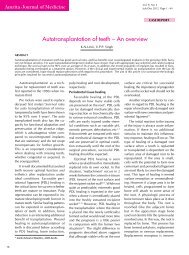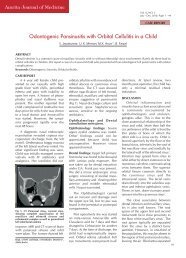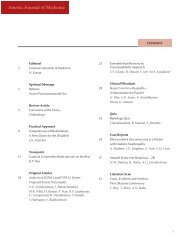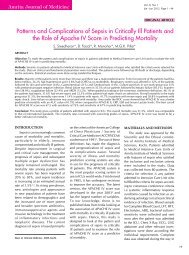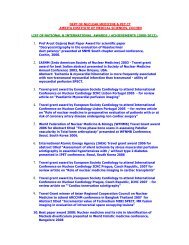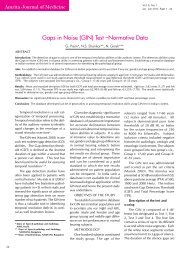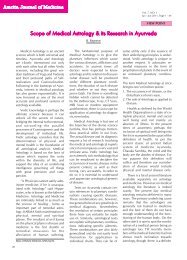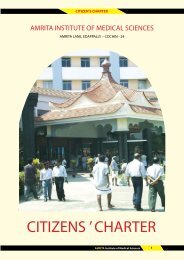Journal of Medicine Vol 2 - Amrita Institute of Medical Sciences and ...
Journal of Medicine Vol 2 - Amrita Institute of Medical Sciences and ...
Journal of Medicine Vol 2 - Amrita Institute of Medical Sciences and ...
Create successful ePaper yourself
Turn your PDF publications into a flip-book with our unique Google optimized e-Paper software.
<strong>Amrita</strong> <strong>Journal</strong> <strong>of</strong> <strong>Medicine</strong><br />
Transfusion-related Acute Lung Injury: A Case Report <strong>and</strong> Review <strong>of</strong> Recent Advances<br />
Table 2: Proposed scheme <strong>of</strong> investigations for an adverse event following a transfusion (Adapted from reference no 43)<br />
S. No. Investigation Comment<br />
1. ABO typing To confirm type<br />
2. Direct anti-globulin test To exclude cross match incompatibility<br />
3. Complete blood counts Transient neutropenia is seen with TRALI.<br />
4. Peripheral blood film Hemolytic cells may be seen in cross match reaction<br />
5. Chest X-ray Needed to exclude pulmonary edema, pneumonia, other reasons for hypoxia<br />
6. Blood cultures Bacterial contamination is a differential diagnosis<br />
7. Anti-body panel Includes anti HLA-1 & HLA-2, anti granulocyte, anti monocyte, anti IgA<br />
8. D-dimer / FDP To evaluate for Deep vein thrombosis<br />
9. ECHO For cardiac function status <strong>and</strong> fluid overload<br />
10. ECG /Cardiac enzymes For cardiac function status (to exclude Myocardial infarction)<br />
11. Undiluted pulmonary From endotracheal tube if present – can be diagnostic if fluid to<br />
edema fluid serum protein ratio is >0.75<br />
ETIOLOGY & PATHOGENESIS<br />
The exact etiology <strong>of</strong> TRALI is unknown, but 2 distinct<br />
mechanisms have been suggested. The traditional<br />
theory proposes an antibody-mediated reaction between<br />
recipient granulocytes <strong>and</strong> antigranulocyte antibodies from<br />
donors who were sensitized during pregnancy (multiparous<br />
women) or by previous transfusion 9,12,34,35 .<br />
Recently, an alternative mechanism has been suggested,<br />
implicating pro-inflammatory molecules,<br />
predominantly lipid products <strong>of</strong> cell degradation, known<br />
to accumulate during storage <strong>of</strong> cellular blood products<br />
19,36,37<br />
.<br />
Both models are based on a two-hit hypothesis wherein<br />
a first hit is required as an initial priming event followed<br />
by a second initiator event. Of note, the 2 hypotheses <strong>of</strong><br />
TRALI pathogenesis are not mutually exclusive <strong>and</strong> even<br />
may act synergistically with underlying patient factors to<br />
produce acute lung injury.<br />
The first insult (first hit) is priming <strong>and</strong> adherence <strong>of</strong><br />
neutrophils to the pulmonary endothelium. C<strong>and</strong>idate<br />
conditions for producing the first insult in TRALI include<br />
surgery, sepsis, trauma, massive transfusions, hematologic<br />
malignancies, cardiac surgeries, induction chemotherapy<br />
<strong>and</strong> cardiopulmonary bypass 23 .<br />
The second insult (second hit) activates these primed<br />
neutrophils, resulting in the release <strong>of</strong> reactive oxygen<br />
species that cause capillary leak <strong>and</strong> pulmonary edema<br />
38<br />
. For the second hit, parity <strong>of</strong> the blood donor, relationship<br />
to the blood donor, <strong>and</strong> the age <strong>of</strong> the blood products<br />
can all be potential risk factors 23 .<br />
Although the antibody theory remains more widely<br />
accepted <strong>and</strong> published, in some cases there is definite<br />
evidence <strong>of</strong> biologically active lipids in the etiogenesis<br />
<strong>of</strong> TRALI.<br />
DIAGNOSIS<br />
The first step in management <strong>of</strong> TRALI is to make a<br />
correct diagnosis. It requires a high index <strong>of</strong> clinical suspicion<br />
<strong>and</strong> awareness about this condition in event <strong>of</strong><br />
any adverse event temporally related to blood transfusion<br />
to diagnose <strong>and</strong> treat this condition effectively. Figure<br />
1 outlines the algorithm for diagnosis <strong>of</strong> a suspected case<br />
<strong>of</strong> TRALI. Too <strong>of</strong>ten, hypoxia that develops after transfusion<br />
therapy is ascribed to volume overload, <strong>and</strong> diuretics<br />
are empirically administered. Mild-to-moderate cases <strong>of</strong><br />
TRALI may be misdiagnosed as volume overload, <strong>and</strong><br />
the chance to make a diagnosis <strong>of</strong> TRALI, <strong>and</strong> possibly<br />
prevent future cases, is lost.<br />
The differential diagnosis <strong>of</strong> TRALI includes,<br />
but is not limited to, transfusion related circulatory overload,<br />
anaphylactoid reaction to transfusate, bacterial<br />
contamination <strong>of</strong> tranfusate, <strong>and</strong> hemolytic transfusion<br />
reaction 39 .<br />
There are no specific investigations since there is no<br />
specific abnormality associated with TRALI. However<br />
investigations are required to rule out other possibilities<br />
<strong>of</strong> a transfusion related reaction. Thus in regular clinical<br />
practice, TRALI is a diagnosis by exclusion because it<br />
has no specific symptoms, signs or investigations.<br />
The only routine laboratory parameter that has<br />
been associated, albeit infrequently, with TRALI is leucopenia<br />
39 .<br />
Edema fluid/plasma protein ratio measured by taking<br />
matched samples <strong>of</strong> edema fluid from an endotracheal<br />
tube <strong>and</strong> plasma sample for protein measurements can<br />
38



